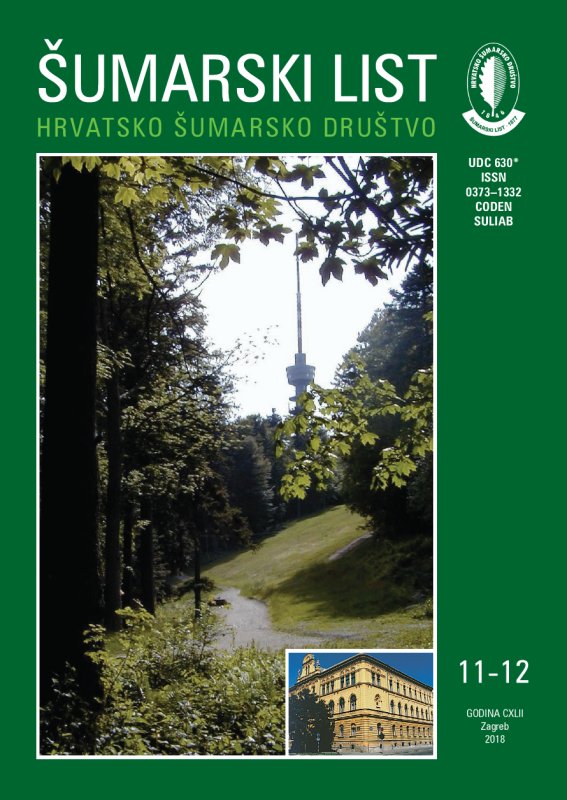
broj: 11-12/2018
pdf (14,99 MB) |
|
||||||||||||||
| RIJEČ UREDNIŠTVA | ||
| Uredništvo | ||
| What percent of the population is aware of the forestry profession? pdf HR EN | 565 | |
| IZVORNI ZNANSTVENI ČLANCI | ||
| Mateo Gašparović, Anita Simic Milas, Ante Seletković, Ivan Balenović | UDK 630* 587 (001) https://doi.org/10.31298/sl.142.11-12.1 | |
| A novel automated method for the improvement of photogrammetric DTM accuracy in forests pdf HR EN | 567 | |
| Mirzeta Memišević Hodžić, Dalibor Ballian | UDK 630* 451 + 153 (001) https://doi.org/10.31298/sl.142.11-12.2 | |
| Phenological variability of pedunculate oak (Quercus robur L.) in Bosnian-Herzegovinian provenance trial pdf HR EN | 579 | |
| Sezgin Ayan, Nezahat Turfan, Esra Nurten Yer, Muhidin Šeho, Halil Barş Özel, Fulvio Ducci | UDK 630* 453 (001) https://doi.org/10.31298/sl.142.11-12.3 | |
| Antioxidant variability of the seeds in core and marginal populations of taurus cedar (Cedrus libani A. Rich.) pdf HR EN | 593 | |
| Cumhur Güngöroglu, Ç. Okan Güney, Abdullah Sari, Ayhan Serttaş | UDK 630* 537 + 238 (001) https://doi.org/10.31298/sl.142.11-12.4 | |
| Predicting crown fuel biomass of Turkish red pine (Pinus brutia Ten.) for the Mediterranean regions of Turkey pdf HR EN | 601 | |
| Fahrettin Atar, Ibrahim Turna | UDK 630* 923 + 619 (001) https://doi.org/10.31298/sl.142.11-12.5 | |
| Fruit and seedling diversity among sweet chestnut (Castanea sativa Mill.) populations in Turkey pdf HR EN | 611 | |
| PRETHODNO PRIOPĆENJE | ||
| Kristijan Tomljanović, Helena Nosek, Renata Pernar, Marijan Grubešić | UDK 630* 156 + 153 https://doi.org/10.31298/sl.142.11-12.6 | |
| Possibilities of applying lightweight unmanned aerial vehicles to big game counting pdf HR EN | 621 | |
| SUMMARY Different techniques and technologies are being used in wild animal research. Goals of such research and monitoring are various, most common are numbers per area and size of population for a researched species (Myslenkov i Miquelle, 2015). Development of new techniques and technologies that are used everyday in practial wild animal monitoring has made many tasks much easier and more precise, usage of technology often decreases the number of people needed to be involved in research and has made some until now unfeasable methods a reality. In conducted research we wanted to explore to what amount is it possible to apply a drone system equiped with thermal camera in assessing some population parameters for big game. Research was conducted in lowland teritorry of continental part of Republic of Croatia within hunting ground Opeka II. Wild boar has been chosen for the research as the most common species of big game in Republic of Croatia. Within two localities (I age grade of Oak forest) testing of two counting methods was conducted. First method was to try and count all neck within researched department. Given results show relatively high numbers of wild boar in average of 1,26 with sd=+/- 0,18 necks/ha within researched plane. Second utilized method was to count wild boar on in advance determined strips, whose share in total observed surface amounts to 10%. In this method infomation are of bigger variability and somewhat smaller number off wild boar within observed plane has been determined in amount of 0,61 neck/ha with very high sd=+/- 0,53. Researched confirmed the posibility of applying drone systems with thermal cameras. From two applied methods, first (absolute counting of all animals) is more suitable for smaller surfaces, while the method of appropriate strips is more suitable for larger surfaces with conscious risk of generating greater counting error. Key words: lightweight unmanned aerial vehicles; drone; hunting management; remote sensing; wild boar (Sus scrofa); big game counting | ||


